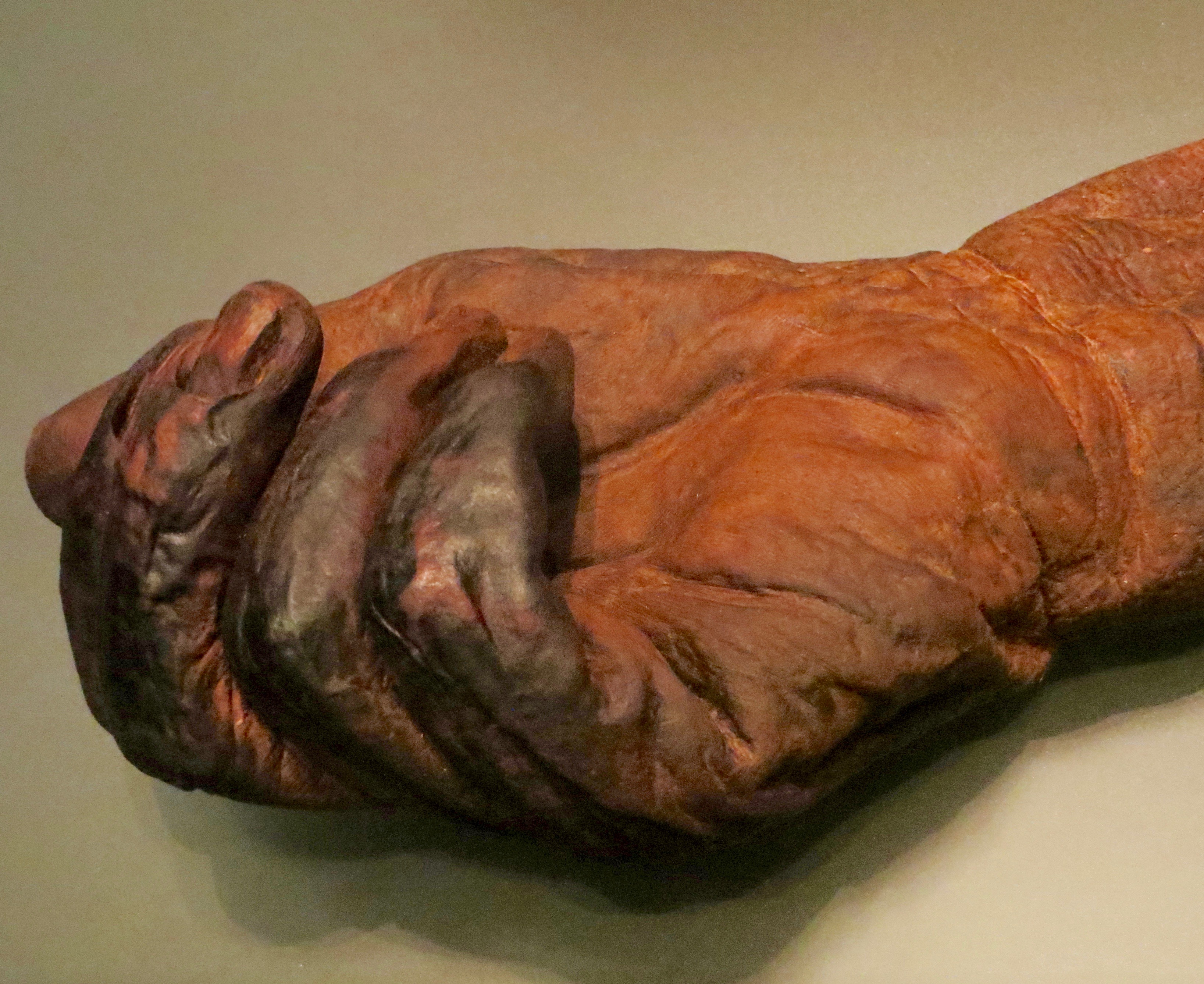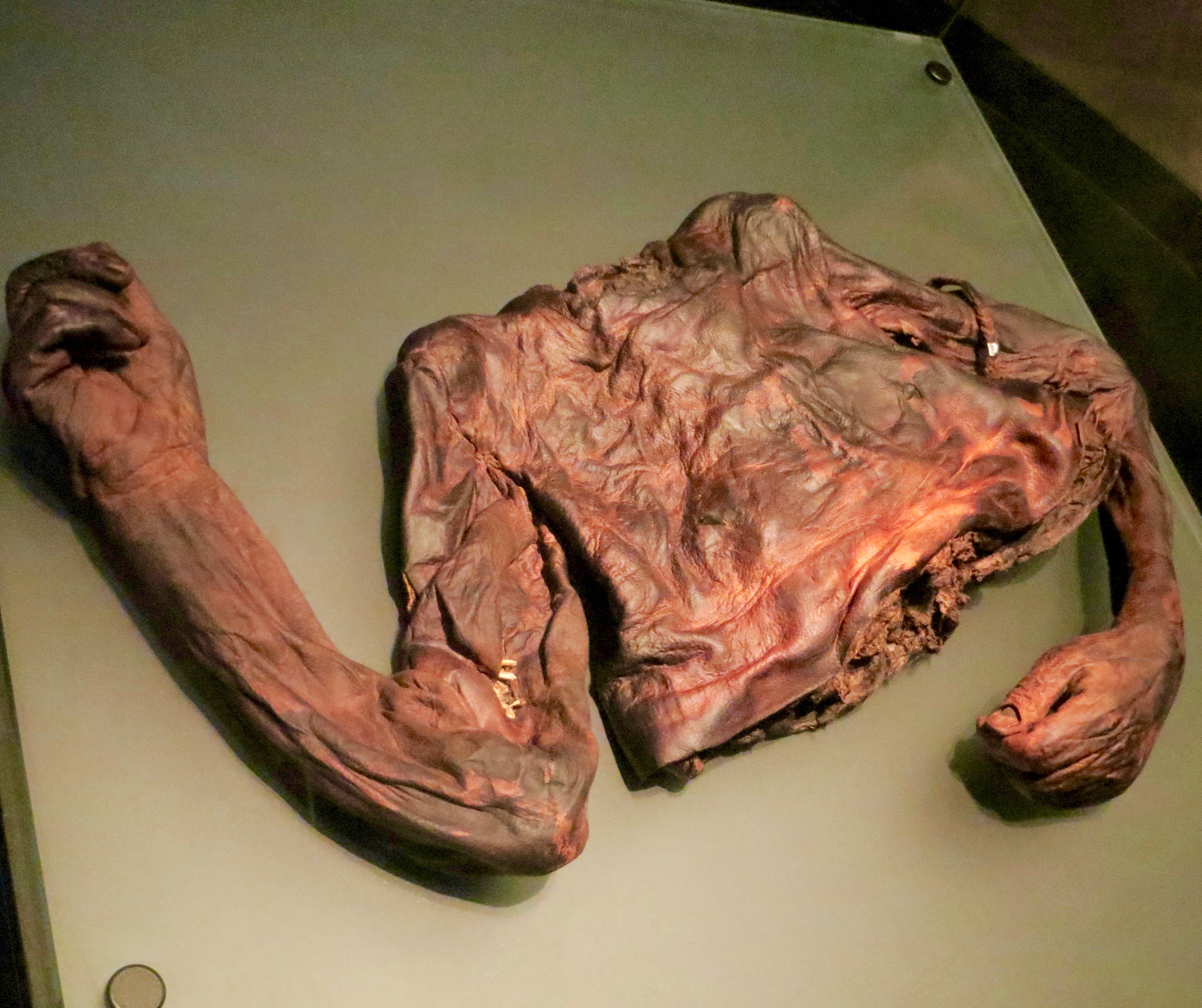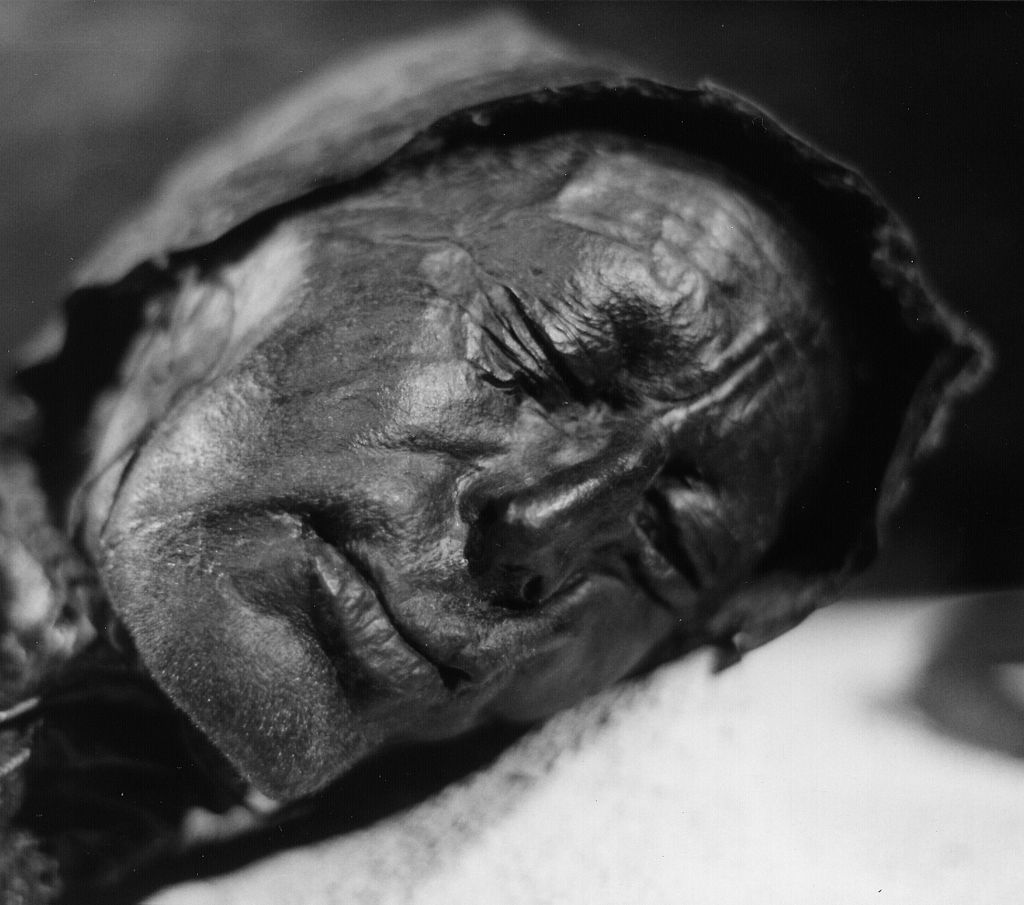
Seeing the relaxed hand of a reclining man is nothing special … unless it’s 2,400 years old and on display in a glass museum case. This incredibly well-preserved hand, and the leathery-looking torso to which it’s attached belong to the Oldcroghan Man. Dated around 300 BCE, he’s one of the famous bog bodies on display in the National Museum of Ireland in Dublin.


Even though slightly morbid, I find bog bodies fascinating. Unlike stone ruins and museum artifacts, bog bodies are a very human connection to our ancient past. These were people like us living day-to-day in an uncertain world who were unfortunate enough to end their days preserved for eternity in an Irish wetland.

Peat bogs are a natural lab for some weird chemical experiments. Their combination of cold, wet, acidic, and oxygen-free conditions not only stops decomposition, but make them the perfect place to preserve human skin, hair, and internal organs. The chemical process is complex, and as creepy as it sounds, bones are dissolved and the bodies are “tanned” – similar to the process used to create traditional animal-skin leather.
“Half earth, half water and open to the heavens, they were borderlands to the beyond. To these people, will-o’-the-wisps—flickering ghostly lights that recede when approached—weren’t the effects of swamp gas caused by rotting vegetation. They were fairies.” –Smithsonian Magazine

Much of what we know about bog bodies is based on educated guesses and scientific conjecture, and we may never have a clear understanding of who they were or why they ended up in a watery grave. But given their amazing state of preservation, these remains left behind clues about the people and life at the time.
It takes teams of trained scientists, but modern techniques and detailed analysis help to draw specific conclusions about the body: sex, age, health, diet, social status, and cause of death. Clonycavan Man’s perfectly preserved stomach contents indicated not only what he ate for his last meal, but the specific grains and seeds tells us what time of year he died. Also, his extraordinary hairstyle, held in place by gel made from a resin from France or Spain meant he was a high status person.

Twenty percent of Ireland is covered by bogs, and with its long history of harvesting peat for fuel, a number of discoveries have been made there. But wetland archaeologists have had success all over Northern Europe, and strangely, many of the bodies had a very violent death.
According to the museum exhibit placard, Clonycavan Man was “killed by a series of blows to the head, probably by an ax. He also suffered a 40cm-long cut to his abdomen suggesting disembowelment.”

Other bodies had been strangled, hanged, stabbed, and bashed on the head: a veritable murderers’ menu. In the professional community this gruesome savagery is called “overkill,” and it’s one of the greatest mysteries facing scientists. Why exactly were these Iron Age deaths so violent? Was it a harsh lesson for other criminals, a ritual sacrifice to appease the gods, or just brutal murder?

In our world wetlands are considered an essential component for maintaining a healthy environment. But obviously, in our ancient past bogs were powerful and mysterious places for very different reasons. And though we may never solve the mystery, it’s an intriguing part of our history, and the real human connection makes it even more meaningful.
Happy Trails and Good Health,
James and Terri
Last Updated September 5, 2023

Photo Credits: 1. Michal Klajban 5. Ivar Leidus
Thank you for this fascinating post. That last photo … wow!
Yvonne, these photos are surprising, and I must say that seeing a couple of bog bodies in a quiet, slightly darkened museum room is even more intriguing and disconcerting. ~James
I can’t help but think of the scenes from the Lord of the Rings trilogy where on their journey to Mordor, Frodo and Sam encountered a marshy land filled with petrified dead bodies. Looking at your photos for some reason reminded me of them — not in a bad way though as I’m really intrigued by bogs.
Bama, you never know where creative types get their inspiration, but I wonder about this scene. I didn’t mention it in the post, but when some of these bodies were initially discovered, the police were called in and they were processed and fingerprinted as murder suspects … amazing. ~James
Amazing. The fact that these bodies were so well preserved must mean we were meant to discover them and learn about the past. Have you seen any of these yourself?
Interesting perspective Darlene. From my reading it appears that many of these were discovered by accident. Imagine the surprise!
And yes, we visited the Dublin Museum on our last trip to Ireland and saw these bodies. The exhibit was fascinating to see, but as you can imagine, it’s a bit disconcerting. I took the close-up photo of the hand, and I must admit, it gave me pause. This was the “human connection” the post talks about. ~James
Fascinating!
Anabel, the bog bodies are an unusual and wonderful exhibit. And in fact, the entire museum is interesting, and if you get over Dublin way, it’s definitely worth a stop. ~James
Mesmerizing! I need more hours in a day so that I can dig more into this fascinating topic. Thanks for introducing me/us to the people of the bog. Leathery skin ‘n all 😉
Amit, I’ve read all about the chemical process that makes this work, but am still amazed that it happens and that so many bog bodies been discovered. I’ll never look at a wetland the same again. ~James
Incredible post. Never heard about this. Kind of like the Body Humans that tours the world. https://www.youtube.com/watch?v=7EAeTkZ7Xow
Thanks for the link. I’ve seen this exhibit advertised but have never been able to catch it. After seeing this exhibit no one could have an excuse for not understanding human anatomy. And with the creep factor, someone really took a chance on pulling this show together. ~James
Amazing! Thank you for sharing this fascinating information. I would love to be able to look into each one’s past and see their stories.
Because they’ve found men, women, and even children, I’d love to know the stories as well. Was it an accident, murder, sacrifice, or just bad luck? We’ll never know but it leaves lots of room for our imagination to go wild. ~James
Too bad the ancient Egyptians didn’t know about this process of preservation. It seems to be a better method. In a murder, the bog would be a perfect place for body disposal. However, I guess the murderer wouldn’t be thinking of the excellent preservation properties of the evidence. Very interesting post James & Terri.
Leslie
Thanks Leslie. I read an article in the Smithsonian Magazine that discussed the scientific evidence for the first documented human murder. According to the evidence it was some 430,000 years ago, so we humans have been killing each other for a long, long time. I guess that a peat bog seemed like a the perfect hiding place. ~James
It’s a bit late for any recourse….
I thought Pompeii was eye-popping but the bogs of Ireland are…gob smacking. I just finished reading a book ( The Guest List) that spoke frequently about Irish bogs and how they could swallow people easily. it seems as though these fellows didn’t just fall in necessarily. A creepy and fascinating post James. We did not visit the Dublin museum but should we return my curiosity will take me there.
When we visited the museum in Dublin I didn’t realize the bog bodies were there, but even with the creep factor, I’m very glad we saw the exhibit. And given this post, I think that “The Guest List” should be required reading. I checked out the blurb and reviews and it looks like a fun read. ~James
Like Sue, I immediately thought of Pompeii, James, although the bog bodies seem even more real. Fascinating post, but as you mentioned, a tad creepy, especially if you consider all of the murders. I’d like to see the displays but not so sure I would like to be locked up with them on a pitch dark night. 🙂 –Curt
Curt, I keep a mental list of my “least favorite ways to go” and being buried alive by lava is near the top. And before your ask, Numero Uno is being buried alive. Like the bog bodies, the casts of the humans buried at Pompeii are fascinating and scientifically informative, but it’s impossible to imagine how horrific their deaths must have been. ~James
My guess is the best we can hope for in the deaths at Pompeii is fast…
Amazing.
Pam, bog bodies are amazing for so many reasons: the preservation, historical information, and most of all that they were ever discovered. ~James
I enjoyed the post very much! The state of preservation is just stunning.
Extremely interesting! And the explanation of “fairies” is much more mysterious and fun than “swamp gas.”
Marilyn, I was wondering what was so special about bogs that would make them exceptional places to these Iron Age people, and the mysterious swamp lights are a good answer. I’ve never seen the lights, but I’m sure it would be unsettling even today. And you’re right, fairies sound much more romantic than swamp gas. 🙂 ~James
This was really fascinating. I had heard of them, but not for many years so I’d forgotten about them, and I don’t think I’ve ever seen pictures like these. Quite amazing.
Alison
Alison, there are a few of these bog body exhibits scattered around Northern Europe, and if you ever get a chance to visit one don’t miss it. The mystery surrounding the practice is very curious, and it’s certainly thought provoking about all the skeletons (no pun intended) hiding in our human closet. ~James
Fascinating post! Do you know if they all come from the same general timeframe or were they deposited in bogs throughout the ages? Should I return to Dublin I would add this museum to my list.
Carol, the bodies were spread geographically across the UK and Northern Europe as well as across a 1200 year period. In fact, for that reason some academics say that we should be careful about painting them all with the same brush when it comes to looking for why and where they were laid to rest. ~James
What a fascinating account. I’m inspired to revisit our museum in Dublin as soon as restrictions ease. Many thanks!
Shane, the bog bodies exhibit was fascinating, and in fact, the entire Irish History section was very well done and extensive. It was more than a Yank could absorb, but I’m sure you’ll be able to appreciate all of it. I hope restrictions ease soon. ~James
Yes James, we’re emerging, blinking, into daylight now. By Autumn, perhaps, more options still. Meanwhile, we’ll travel joyfully through WordPress.
Bog bodies…I’ve learned something new! Thank you! They are unbelievably well preserved. This museum is going on my list.
Caroline, it should be part of any trip to Dublin for sure. Ireland has a deep, rich history and the bog bodies add a unique twist that make it even more interesting. Hopefully, we’ll all be able to travel again soon. ~James
I first heard about big bodies when I read “meet me at the museum”, a delightful novel about 2 lonely people who correspond about the Tollund Man. I hadn’t seen a photo of Tollund man so I’m glad your post included it.
Sent from my iPhone
Shelley, the Tollund Man is absolutely amazing for so many reasons. Thanks for the heads up on the book. I’m always looking for new authors and I read the blurb and it sounds very intriguing. ~James
It was slow going at first, but I kept going because it was a book club selection. I had feared it was “chick lit”, but fortunately I was wrong.
Gruesome and at the same time fascinating. I had no idea that bog can preserve the body so well. We recently visited Otzi, the 5000 years old iceman at a museum in Bolzano, Italy. Another incredible finding that has changed history. Next time I visit Dublin, I will definitely visit this museum, great post.
Gilda, I’m envious of your visit to see Otzi. He has been on our radar for years, and if Covid ever allows us to get to Italy again, I hope to make it to the museum. If I knew that I could make the contribution to science that Otzi has I wouldn’t mind being freeze-dried either … after I’m dead of course. 🙂 ~James
Amazing blog. WOW
Thanks Marcella. We’re pleased that you enjoy it. ~James
It’s an amazing blog, feel free to follow me. I am posting more posts soon so get ready.
How fascinating! I had no idea bogs did/do? such an amazing job of preserving human remains. I would never, ever, have imagined murder to be so high on the list of causes of death. Image having your DNA history link you to one of the bog bodies, a bit chilling.
Do the bogs also preserve animals?
Laura, I had the same question about animals as well. Apparently, there have been a few animals found, but not many. After all, most critters are made of the same stuff as we are, but I suspect that this low discovery rate mostly comes down to size.
As for murder, from my reading most scientists seem to think that most of the bodies are sacrifices, criminal executions, or something else rather than murder. But, we humans have been killing each other for a long time, so who knows. ~James
I should have used the term, non-natural death, but yes we certainly don’t learn very quickly.
Laura, just a bit of human murder trivia from another comment: I read an article in the Smithsonian Magazine that discussed the scientific evidence for the first documented human murder. According to the evidence it was some 430,000 years ago. We never learn.
Not sure I can say this is a lovely blog post this week, but it certainly is fascinating. And your pictures take me right to the heart of all these findings. You’re making me want to return to Ireland — there’s so much we missed the first time.
Rusha, I’m not surprised that you, and a few others, found this topic a bit creepy. I guess that most of us are a bit squeamish when it comes to bodies, preserved or otherwise. But for me, the science was so interesting that I couldn’t resist posting.
As for Ireland, we love stopping there on our way to Europe and beyond because it’s so welcoming and only a short hop from the East Coast. ~James
The science of it is very interesting. I’m just glad I’m not the one studying it!
Wow, this is very intriguing. I had no idea there was such a thing. So interesting to see them so well preserved!
Amy, I had read about bog bodies and was pleasantly surprised to actually see one in Ireland. They’re a window into our past, and even though they raise as many questions as they answer, I still find them fascinating. ~James
Fascinating indeed!!
Thanks for this important history share!
Kinda morbid but interesting how deep ancient peat bogs can preserve. I worked for a major construction engineering project in Metro vancouver out in the ‘burbs. They found a native Indian archaelogical site where by law, we had to stop constructions for an archaelogical team to do some digging and take some samples, artifacts. They found some fishing and hunting implements over 3,000 years old.
Jean, as you know, depending on ones point of view this can be the worse thing to happen or the best. It’s always exciting to hear about discoveries like this, and I would certainly hate for the scientific knowledge and valuable artifacts to be lost just to same money on a construction project. ~James
I believe it’s written into provincial legislation about archaelogical discoveries during a construction dig/excavation for construction. By law, the construction project manager, must stop activity, etc.